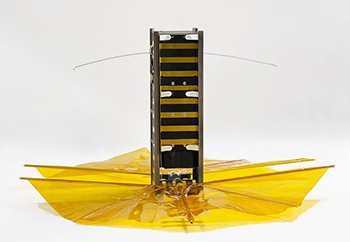A collaboration between The National Research Council, CNR, Florence, Italy and Brown University’s School of Engineering has developed the SBUDNIC satellite. Launch of the 3U CubeSat on a SpaceX Falcon 9 rocket is planned for May 25. The satellite will be released into orbit by the ION Satellite Carrier platform of the space logistics company D-Orbit.
The project was led by a team of students, professors and researchers from Brown University and the Institute on Atmospheric Pollution of the National Research Council (CNR-IIA) and involved the construction of a 3U CubeSat (3 units) using a completely Open architecture approach to enable other laboratories and researchers to do their own experiments and spacecraft quickly and at unprecedented low cost. SBUDNIC takes advantage of commercial components commonly used on Earth, including an Arduino processor and AA Energizer batteries. These parts are rapidly and widely available and affordable. The CubeSat will orbit at an altitude of 500 kilometers and will allow the download of low resolution images in the amateur radio band.

"SBUDNIC is a New Space experiment: it shows that it is really possible to access space with a limited budget and commonly used parts, in a few months, from idea to launch," says Lorenzo Bigagli, researcher at the Florence branch of CNR-IIA and project manager with Rick Fleeter, Associate Professor of Engineering at Brown University.
"We are working to bring space closer to Earth using economical, commonly available components to provide rapid, affordable access to space. SBUDNIC offers researchers the ability to do experiments in space almost as they would do them in their own laboratory with components available at the hardware store or Amazon, following simple, openly available architectures in hardware and software," Fleeter comments.
The scientific cooperation launched by CNR-IIA and the Brown University School of Engineering with the support of NASA Rhode Island Space Grant aims to develop new techniques and skills in Earth observation and its applications, with particular attention to teaching and knowledge transfer, as well as to promote open access to documentation, software and other information and resources for developing Earth observation capabilities.
The Director of CNR-IIA, Francesco Petracchini, stated: "The collaboration with Brown University will allow us to work together to implement Earth observation techniques thanks to innovative satellite technologies, tools that may prove to be of fundamental importance in addressing global challenges."
SBUDNIC's key goal of making space exploration more accessible is not limited to the availability of the parts used. Since the entire satellite project follows the Open Architecture philosophy, it is hoped that future engineers will be able to take inspiration from SBUDNIC to advance space exploration in universities, research and industry.
The SBUDNIC project is also supported by D-Orbit, AMSAT-Italy, La Sapienza-University of Rome and NASA Rhode Island Space Grant under award number 80NSSC20M0053.
READ MORE AT: https://sbudnic.space/